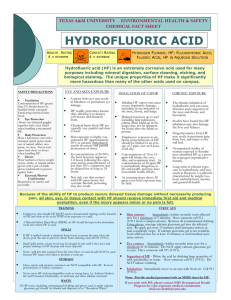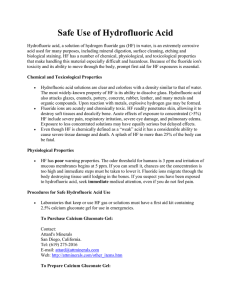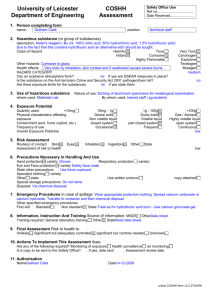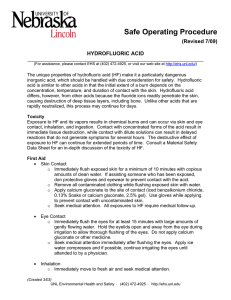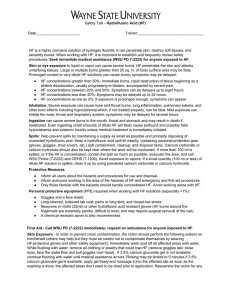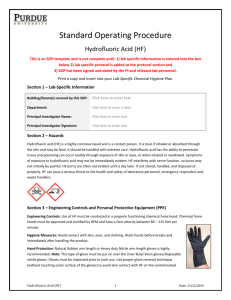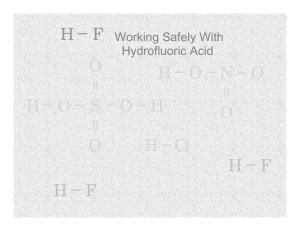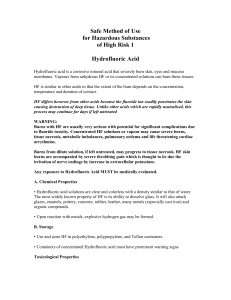Hydrofluoric Acid - Binghamton University
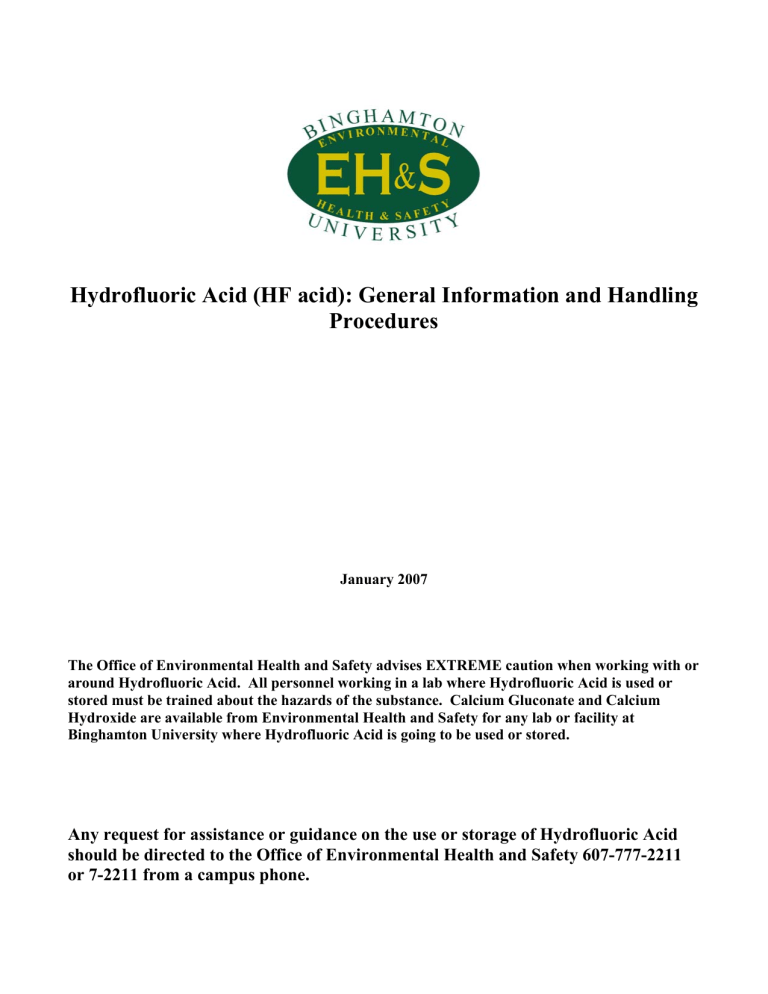
Hydrofluoric Acid (HF acid): General Information and Handling
Procedures
January 2007
The Office of Environmental Health and Safety advises EXTREME caution when working with or around Hydrofluoric Acid. All personnel working in a lab where Hydrofluoric Acid is used or stored must be trained about the hazards of the substance. Calcium Gluconate and Calcium
Hydroxide are available from Environmental Health and Safety for any lab or facility at
Binghamton University where Hydrofluoric Acid is going to be used or stored.
Any request for assistance or guidance on the use or storage of Hydrofluoric Acid should be directed to the Office of Environmental Health and Safety 607-777-2211 or 7-2211 from a campus phone.
Hydrofluoric Acid (HF acid): General information and handling procedures
Hydrofluoric acid (HF) is an EXTREMELY dangerous chemical and should be handled with the utmost caution. It is very toxic by inhalation, skin and eye contact and ingestion and causes severe burns where the effects may not be felt until a few hours after exposure. By this time it is often too late to rescue damaged tissue so emergency procedures should be instituted
IMMEDIATELY and whenever there is any reason to suspect exposure to the chemical...
The high toxicity of HF is evidenced by the fact that a spill over 2% of the body (about the size of the palm of your hand ) with 70% HF can be fatal. Before using the chemical, thoroughly read the MSDS sheets and acquaint yourself with emergency spill management procedures and also personal exposure protocols.
If you suspect ANY contact with this acid commence emergency procedures immediately and seek medical advice. The first symptom of skin exposure is a delayed throbbing, the death of skin, tissues, blood vessels and even bone may follow.
The dead tissue/skin may have a white color. Inhalation causes an intolerable prickling beneath the breastbone.
This acid is unlike others in that it often will not produce noticeable burns until well after the event so it is important to take the Hydrofluoric acid information sheets with you .
Do not be embarrassed by assuming that doctors may not know about HF because many of them don't. Unfortunately there have been cases where treatment has involved the processes used for other acid burns. Hours later the pain from the burn has become excessive and amputation has been required.
HEALTH HAZARDS
Skin Contact In the short term skin contact with concentrations of this acid above 40% will cause immediate burning and intense pain. At concentrations between 20-40% the effects may not be felt for a few minutes but there may still be intense pain. At concentrations less than 20% the effects may be delayed for up to 12 hours at which time extreme pain may be felt. HF is fat soluble meaning it penetrates the skin extremely easily. Consequently in the longer term it binds tissue calcium and decalcifies bones leading to tissue necrosis which may result in amputation.
Skin burns may become gangrenous and spread, and depending on the severity of the burn, nerve, heart and intestinal malfunctions may ensue. Death is usually due to heart failure.
Inhalation Inhalation of HF fumes results in dilute solutions of the acid being formed in the body. Inhalation of weak vapour concentrations can cause irritations of the nose, throat and respiratory tract, particularly the lungs. Inhalation of higher concentrations can cause internal burns of the respiratory tract leading to bronchitis, pneumonia and pulmonary edema (fluid in the lungs). It can also cause severe damage to the teeth as it binds calcium.
At high concentrations inhalation of the fumes can lead to excessive fluid build up in the lungs and death!
Eye contact Both splashes in the eye and eye exposure to HF vapor / gas fumes in the eyes can cause burns with irreversible effects. The cornea may become clouded and any contact may lead to blindness.
Ingestion Ingestion of HF causes burns to the intestinal tract. In extreme circumstances it may even cause perforation of the body, literally meaning that it can cause your body to become a sieve.
FIRST AID
Important: No causality exposed to hydrofluoric acid should be allowed to go home or return to work without having seen a doctor who is aware of the nature and extent of the exposure (who has read the HF information sheets)
Skin contact Wearing gloves, remove and bag the contaminated clothing including footwear immediately and thoroughly and as quickly as possible flood the area with water for at least 1 minute. There are showers in labs E123 and E125. Apply calcium gluconate gel (2.5%, in the fridges in labs E124 and E126) liberally to the area and massage in gently wearing gloves. If a thick white dead tissue mass has formed apply the gel around and through the dead tissue. Continue to re-appy every 15 minutes until medical help arrives. The emergency services should be called as soon as possible on 1 000. APPLYING THE
GEL AS SOON AS POSSIBLE AFTER EXPOSURE IS VITAL!
Inhalation Remove the contaminated person to fresh air and if unconcious commence CPR and artificial respiration. AVOID MOUTH TO MOUTH CONTACT AND INHALING PATIENTS EXHALE.
Obtain medical attention by calling 1 000 immediately as potentially fatal effects may follow. Take
MSDS with you when obtaining medical attention.
Eye contact Eye burns should be treated as severe. Immediately flush out the eye gently with running water for at least 15 minutes with the eyelids kept apart and away from the eye. Be careful not to contaminate the unaffected eye. Do not apply calcium gluconate gel into the eye as this has its own consequences but seek medical attention immediately by calling 1 000.
Ingestion Wash mouth out thoroughly with water. DO NOT swallow the mouth wash water. If acid has been swallowed give water, milk or 6 calcium gluconate or calcium carbonate tablets dissolved in water to drink. DO NOT induce vomiting. Seek medical attention by calling 1000, providing MSDS and HF information sheets when the ambulance arrives.
HANDLING PROCEDURES
READ the HF information sheets, handling protocol, first aid, and the spill management guidelines.
ALWAYS register usage of 50% HF (in book/board provided)
ALWAYS wear the appropriate safety equipment comprising safety glasses, 1 or 2 pairs of latex gloves, and over pair of nitrile gloves, a lab coat and protective sleeves. DO NOT wear contact lenses. When decanting or handling volumes greater than 250ml you must also wear an apron and face shield in addition to the other safety equipment.
Note: Aprons are personal issue and should be named and labeled “Front” and “Back” and be cleaned regularly by the owner. Nitrile gloves are also personal issue and should be named and cleaned regularly inside and out.
Prior to removal they should be rinsed in the fume hood and left to dry on the lip of the fume hood.
ALWAYS work in the fume cupboard.
ALWAYS use plastic beakers when working with HF. HF dissolves glass. When refilling a container, always inspect it for signs of decay such as crazing, cracks, or becoming brittle as the HF will affect plastics over a long period. New containers must be dated and discarded after 6 months regardless of their visible condition.
NEVER work alone
NEVER rush while working with HF solutions. Avoid generating and breathing mist and vapour
AVOID distractions while working with HF in any form
ALWAYS keep the solutions as far away from you as is practical and comfortable
ALWAYS work smoothly and slowly, especially when transferring solutions and cradles
KEEP solutions well back in the fume hood
ALWAYS treat any drops on you or the bench while working with HF with extreme suspicion and act as if a spill has occurred
NEVER open bottles of HF or have open solutions of HF anywhere other than an operating fume hood
AVOID excessive movement in front of a fume hood (creating drafts) while open solutions are present and don't fill the fume hood up with equipment
REMOVE lids carefully to avoid flicking any drops condensed under the lid on the bench or yourself
REMEMBER that HF boils at 18 o
C and consequently in most lab conditions vapors will be present
REMEMBER never to touch anything like doorknobs or cupboard handles with gloves that may have been contaminated with HF . Leave contaminated gloves in the fume cupboard.
ALWAYS have on hand powdered Calcium Hydroxide Ca(OH)
2
and know where the calcuim gluconate gel is stored.
ALWAYS wash hands with soap and water after handling HF
KNOW your protocols, spill management procedures and first aid before commencing use of the chemical
INCOMPATIBILITY AND SUITABLE CONTAINERS
Only containers made from chlorinated polyethylene (eg. HDPE), neoprene and nitrile rubber should be considered resistant to the effects of HF. Never store the solution in glass containers as it etches and may eat through the container.
Contact with metals, strong bases, fluorine, potassium permanganate and bismuth acid should be avoided and in general avoid any alkalis and strong reducing agents. It reacts adversely with organics such as acetone and any contact between these compounds should be avoided.
EMERGENCY RESPONSES
FIRE
Fire may produce poisonous or irritating gases. Violent exothermic reaction occurs with water. Sufficient heat may be produced to ignite combustible materials. Reacts with metals forming flammable hydrogen gas.
Keep upwind of fire. Use water or carbon dioxide on fires in which HF is involved. Halon or foam may also be used.
In case of fire, the sealed containers can be kept cool by spraying with water.
In the event of a fire, wear full protective clothing and NIOSH-approved self-contained breathing apparatus with full face piece operated in the pressure demand or other positive pressure mode. Avoid getting water in tanks or drums; water can cause the generation of heat and spattering. In contact with air, the acid gives off corrosive fumes which are heavier than air.
SPILL
See the Binghamton University Hazardous Waste Guide for direction on how to clean up spills. A calcium hydroxide powder should be used to neutralize any spill-do not use Petrosorb or “kitty litter” to clean up
Hydrofluoric Acid spills until it has been neutralized with a calcium-containing basic powder.
